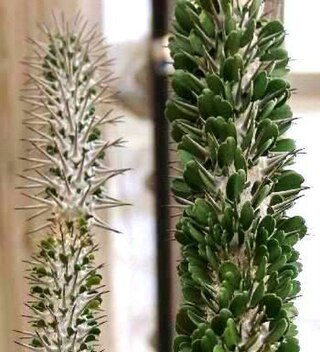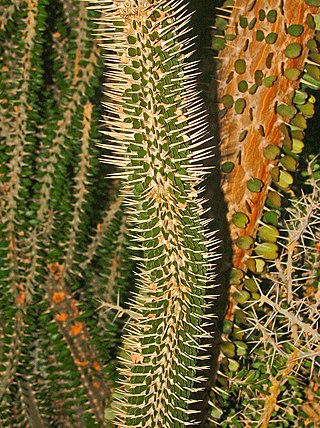
The Afrotropical realm is one of the Earth's eight biogeographic realms. It includes Sub-Saharan Africa, the southern Arabian Peninsula, the island of Madagascar, and the islands of the western Indian Ocean. It was formerly known as the Ethiopian Zone or Ethiopian Region.

Pachypodium is a genus of succulent spine-bearing trees and shrubs, native to Madagascar and Africa. It belongs to the family Apocynaceae.

Alluaudia is a genus of flowering plants in the family Didiereaceae. There are six species, all endemic to Madagascar.

Didiereaceae is a family of flowering plants found in continental Africa and Madagascar. It contains 20 species classified in three subfamilies and six genera. Species of the family are succulent plants, growing in sub-arid to arid habitats. Several are known as ornamental plants in specialist succulent collections. The subfamily Didiereoideae is endemic to the southwest of Madagascar, where the species are characteristic elements of the spiny thickets.

Alluaudia procera, or Madagascar ocotillo, is a deciduous succulent plant species of the family Didiereaceae. It is endemic to south Madagascar.

Isalo National Park is a National Park in the Ihorombe Region of Madagascar, in the southwestern corner of the Province of Fianarantsoa. The closest town is Ranohira, and the closest cities are Toliara and Ihosy. It is a sandstone landscape that has been dissected by wind and water erosion into rocky outcrops, plateaus, extensive plains and up to 200 m (660 ft) deep canyons. There are permanent rivers and streams as well as many seasonal watercourses. Elevation varies between 510 and 1,268 m.

The composition of Madagascar's wildlife reflects the fact that the island has been isolated for about 88 million years. The prehistoric breakup of the supercontinent Gondwana separated the Madagascar-Antarctica-India landmass from the Africa-South America landmass around 135 million years ago. Madagascar later split from India about 88 million years ago, allowing plants and animals on the island to evolve in relative isolation.

The long-tailed ground roller is a species of bird in the ground roller family Brachypteraciidae, placed in the monotypic genus Uratelornis. Endemic to arid spiny forests near the coast in southwestern Madagascar, this ground roller occurs at extremely low population densities throughout its habitat. This species requires shade and a deep layer of leaves on the ground, and it is absent from parts of the spiny forest lacking these features. It has no recognized subspecies, and its closest relative is the scaly ground roller. The long-tailed ground roller is the only ground roller to definitively display sexual dimorphism. It is a medium-sized bird with a plump silhouette and a long tail. The upperparts are dark brown with black streaks while the underparts are light gray. The white throat is framed by black malar stripes and a black breastband, and a white stripe is present at the base of the bill. Sky-blue feathers are visible at the edge of the wings and the tail. Calls are rarely made outside the breeding season, though multiple courtship calls are made.

The white-footed sportive lemur, white-footed weasel lemur, or dry-bush weasel lemur is a species of lemur in the family Lepilemuridae, the sportive lemurs. It is similar in appearance to other lemurs in the family, with a grey back, a pale grey to white ventral side, and a light brown tail. It is a nocturnal animal that moves through the forest using a vertical clinging and leaping technique. It is endemic to Madagascar, inhabiting the southern subtropical or tropical dry shrubland. It is threatened by habitat loss due to agriculture practices and charcoal production.

The Paleotropical kingdom (Paleotropis) is a floristic kingdom composed of the tropical areas of Africa, Asia and Oceania, as proposed by Ronald Good and Armen Takhtajan. Part of its flora is inherited from the ancient supercontinent of Gondwana or exchanged later. These Gondwanan lineages are related to those in the Neotropical kingdom, composed of the tropical areas of Central and South America. Flora from the Paleotropical kingdom influenced the tropical flora of the Australian Kingdom. The kingdom is subdivided into five floristic subkingdoms according to Takhtajan and about 13 floristic regions. In this article the floristic subkingdoms and regions are given as delineated by Takhtajan.
Midongy du sud National Park is a national park in the region of Atsimo-Atsinanana, in south-east Madagascar. The 192,000 hectares park has the second largest rainforest on the island and is rich in endemic animals and plants, especially medicinal plants.

Tsimanampetsotsa National Park also spelt Tsimanampetsotse, and known as Tsimanampetsotsa Nature Reserve is a 432 km2 national park on the south-west coast of Madagascar in the region Atsimo-Andrefana. The park is 90 kilometres (56 mi) south of Toliara and 950 kilometres (590 mi) south of the capital, Antananarivo. Route Nationales (RN) 10 to Faux Cap passes the park and the nearest airport is at Toliara. The national park contains and is named after Lake Tsimanampetsotsa.

Zombitse-Vohibasia is a national park in the Atsimo-Andrefana region of south-west Madagascar. It is 147 kilometres (91 mi) north-east of the town of Toliara on the National road 7.

Emmanuel Drake del Castillo was a French botanist.

Didierea madagascariensis, commonly known as the octopus tree, is a species of Didiereaceae endemic to the spiny thickets of southwestern Madagascar. It was first described scientifically by the French botanist Henri Ernest Baillon in 1880 and is the type species of the genus Didierea.

Alluaudia montagnacii is a rare species of flowering plant in the family Didiereaceae.

The flora of Madagascar consists of more than 12,000 species of plants, as well as a poorly known number of fungi and algae. Around 83% of Madagascar's vascular plants are found only on the island. These endemics include five plant families, 85% of the over 900 orchid species, around 200 species of palms, and such emblematic species as the traveller's tree, six species of baobab and the Madagascar periwinkle. The high degree of endemism is due to Madagascar's long isolation following its separation from the African and Indian landmasses in the Mesozoic, 150–160 and 84–91 million years ago, respectively. However, few plant lineages remain from the ancient Gondwanan flora; most extant plant groups immigrated via across-ocean dispersal well after continental break-up.

Alluaudia comosa is a rare species of flowering plant. It belongs to the family Didiereaceae, subfamily Didiereoideae, which is found only in the coastal area of SW Madagascar. Didierea comosa Drake is a synonym. It is listed as "vulnerable" on the IUCN Red List of Threatened Species.
Alluaudiopsis is a genus of shrubby flowering plants belonging to the family Didiereaceae. Species of Alluaudiopsis are dioecious, with male and female flowers on separate plants.
Decarya is a monotypic genus of flowering plants belonging to the family Didiereaceae. It has one species, Decarya madagascariensis, a shrub or tree endemic to southern Madagascar. It grows up to 6 meters in height, with zig-zagging branches covered in short spines.


















